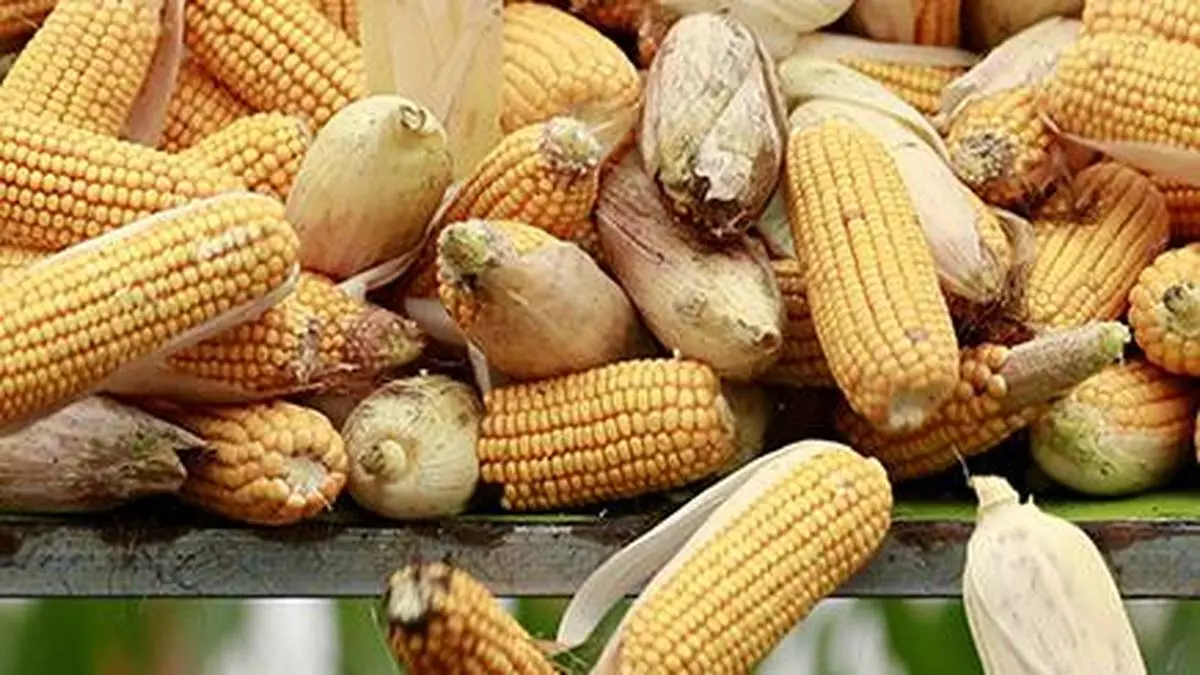Bearish outlook for corn as lower exports may offset decline in output
Corn (maize) prices are expected to rule lower in 2024 compared with 2023 lower global exports are expected to offset the decline in production in key producing nations, analysts have said. Higher-ending stocks are also aiding the bearish outlook.
The Economic Research Service (ERS) of the US Department of Agriculture (USDA) as well as research agency BMI, a unit of Fitch Solutions, have forecast prices that are below $4.50 a bushel ($177.20/tonne).
Corn prices have dropped by over a third year-on-year. Currently, corn July contracts on the Chicago Board of Trade (CBOT) are ruling at $4.46 a bushel, while December futures are quoted at $4.65.
The USDA ERS has projected India’s corn production to remain flat at around 35 million tonnes (mt) in 20224-25 on hopes of a better south-west monsoon.
Corn is driving the increase in feed grain stocks and overall supply, following a record production in 2023-24. Larger supplies are expected to prompt greater feed grain use, and ending stocks are projected higher for 2024-25 at 56.4 mt, up 2.3 mt from the already large ending stocks estimated at the end of 2023/24, the USDA ERS said.
“Consequently, corn prices remain projected at $4.40 per bushel for 2024-25. The production and use projections for 2024-25 U.S. feed grains also remain unchanged,” it said.
“We hold unchanged at $4.30 per bushel our below-consensus forecast for the average price of CBOT-listed second-month corn futures contracts in 2024, which would mark a 22.3 per cent decline compared to the average price in 2023 of $5.54,” BMI said.
Up to June 10, corn contracts traded at an average end-of-session price level of $4.51 per bushel, which indicates that we anticipate further downside through the second half of 2024, it said.
Higher carryover
ING Think, the economic and financial analysis wing of Dutch multinational financial services firm ING said US ending stocks are expected to increase in 2024-25 — the highest since 2018-19. “However, this is still below the close to 2.3 billion bushels the market was expecting,” it said.
The Agricultural Marketing Information System (AMIS) of the Food and Agriculture Organisation, an arm of the UN, said corn production in 2024 will likely decline by 1.3 per cent from the 2023 level with decreases in Brazil, South Africa, Ukraine and the US. “By contrast, bigger harvests are likely seen in Argentina and the EU,” it said.
BMI said recent estimates indicate that total corn production in Argentina, Brazil, and the US, the world’s three largest corn exporters, will be somewhat lower in 2024 than in 2023.
“Nonetheless, recent national estimates suggest that the combined output of these three markets will amount to the second-highest volume on record,” it said.
Global corn output
The total corn output in Argentina, Brazil, and the US is projected to amount to 535.6 mt in 2024 compared with 558.6 mt in 2023 (-4.1 per cent) and to 511.9 mt in 2022 (+4.6 per cent).
“The USDA expects US corn production in 2024-25 to fall by over 3 per cent year-on-year from last year’s record crop. This shouldn’t be too surprising with farmers expected to switch to soyabeans,” said ING Think.
“Both the USDA and the International Grains Council (IGC) forecast season-on-season declines in world corn exports in the 2024-25 marketing year, which we expect will weigh on average prices,” BMI said.
FAO’s AMIS said trade in 2024-25 (July-June) is likely to drop below the 2023-24 level by 2.7 per cent, primarily reflecting smaller purchases by China and lower exports by Brazil and Ukraine.
BMI said Chinese corn imports will ease in the 2024-25 marketing year compared with 2023-24 due to the continued normalisation of the domestic corn-wheat price differential after a period in which relative prices saw the use of feed wheat increase.
The FAO’s agricultural marketing arm said utilisation in 2024-25 is forecast to expand by 1.1 per cent, underpinned largely by growth in feed use, especially in China and, to a lesser extent, Brazil and the Russian Federation.
ING Think, quoting USDA, said global ending stocks for 2024-25 are projected at 312.3 mt, down 0.8 mt from 2023-24, but quite some distance from the almost 319 mt the market was expecting.
AMIS said stocks (ending 2025) are likely to rise by 3.5 per cent above their opening level, with a large build-up in the EU, as well as smaller increases in Brazil, China, and the US.
BMI said its outlook indicated that the world corn market will likely remain in surplus until MY2027-28 but the surfeit in a single season will not exceed the large surplus generated in 2021-22.
On India, the USDA ERS said timely rains, particularly for the kharif corn crop is expected to alleviate elevated temperatures and improve soil moisture conditions.
